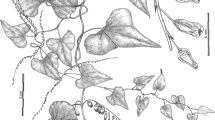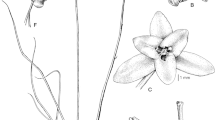Abstract
A new Dactylella species, Dactylella alba was isolated from the ascospores of Orbilia alba collected in Wenshan County, Yunnan Province, China. Conidiophores were either not branched or occasionally branched, bearing divergent sterigmata on the tip with single conidium on each. Conidia were elongated ellipsoids, 1–2 septate, mostly 1 septate. By combining the ITS sequence with morphological characteristics, a new anamorphic species is described and illustrated together with its teleomorph.
Similar content being viewed by others
References
Alexopoulos, C.J., C.W. Mims, and M. Blackwell. 1996. Introductory Mycology, IV edition, p. 188–219. John Wiley & Sons, New York, N.Y., USA.
Chen, J., L.L. Xu, B. Liu, and X.Z. Liu. 2007. Taxonomy of Dactylella complex and Vermispora. I. Generic concepts based on morphology and ITS sequences data. Fungal Divers. 26, 73–83.
Gams, W. 1995. How should anamorph genera be? Can. J. Bot. 73(Suppl. 1), S747–S753.
Grove, W.B. 1884. New or noteworthy fungi. J. Botany 22, 195–201.
Kindermann, J., Y. El-Ayouti, G.J. Samuels, and C.P. Kubicek. 1998. Phylogeny of the genus Trichoderma based on sequence analysis of the internal transcribed spacer region 1 of the rDNA clade. Fungal Genet. Biol. 24, 298–309.
Li, Y., K.D. Hyde, R. Jeewon, L. Cai, and K.Q. Zhang. 2005. Phylogenetics and evolution of nematode-trapping fungi (Orbiliales) estimated from nuclear and protein coding genes. Mycologia 97, 1034–1046.
Liu, B., X.Z. Liu, and W.Y. Zhuang. 2005. Orbilia quercus sp. nov. and its knob-forming nematophagous anamorph. FEMS Microbiol. Lett. 245, 99–105.
Miao, Z.Q, X.Z. Liu, S.D. Li, and M.X. He. 2003. Dactylella pseudoclavata sp. nov., a new nematode-trapping fungus. Can. J. Bot. 81, 1–5.
Mo, M.H., X.W. Huang, W. Zhou, and K.Q. Zhang. 2005. Arthrobotrys yunnanensis sp. nov., the fourth anamorph of Orbilia auricolor. Fungal Divers. 18, 107–115.
Pfister, D.H. 1997. Castor, pollux and life histories of fungi. Mycologia 89, 1–23.
Rubner, A. 1996. Revision of predacious hyphomycetes in the Dactylella-Monacrosporium complex. Stud. Mycol. 39, 1–134.
Schenck, S., W.B. Kendrick, and D. Pramer. 1977. A new nematode-trapping hyphomycete and a reevaluation of Dactylaria and Arthrobotrys. Can. J. Bot. 55, 977–985.
Scholler, M., G. Hagedorn, and A. Rubner. 1999. A reevaluation of predatory orbiliaceous fungi. II. A new generic concept. Sydowia 51, 89–113.
Shenoy, B.D., R. Jeewon, and K.D. Hyde. 2007. Impact of DNA sequence-data on the taxonomy of anamorphic fungi. Fungal Divers. 26, 1–54.
Subramanian, C.V. 1963. Dactylella, Monacrosporium and Dactylaria. J. Indian Bot. Soc. 42, 291–300.
Subramanian, C.V. 1977. Revisions of hyphomycetes-I. Kavaka 5, 93–98.
Swofford, D.L. 2002. PAUP. Phylogenetic analysis using parsimony, Version 4.0. Sinauer Associate, Sunderland Massachusetts, USA.
Webster, J., A. Henrici, and B. Spooner. 1998. Orbilia fimicoloides sp. nov., the teleomorph of Dactylella cf. oxyspora. Mycol. Res. 102, 99–102.
White, T.J., T. Bruns, S. Lee, and J. Taylor. 1990. Amplification and direct sequencing of fungal ribosomal RNA genes for phylogenetics, p. 315–322. In M.A. Innis, D.H. Gelfand, J.J. Sninsky (eds.). PCR protocols: a guide to methods and applications. Academic Press, San Diego, CA, USA.
Yang, Y. and X.Z. Liu. 2005. Dactylella coccinella sp. nov., an anamorphic species. Mycotaxon 91, 127–132.
Yu, Z. F., M. Qiao, Y. Zhang, H.O. Baral, and K.Q. Zhang. 2007a. Orbilia vermiformis sp. nov. and its anamorph. Mycotaxon 99, 271–278.
Yu, Z.F., M. Qiao, Y. Zhang, and K.Q. Zhang. 2007b. Two new species of Trichoderma from Yunnan, China. Antonie van Leeuwenhoek 92, 101–108.
Yu, Z.F., Y. Zhang, M. Qiao, H.O. Baral, E. Weber, and K.Q. Zhang. 2006. Drechslerella brochopaga, the anamorph of Orbilia (Hyalinia) orientalis. Mycotaxon 96, 163–168.
Yu, Z.F., Y. Zhang, M. Qiao, and K.Q. Zhang. 2007c. Orbilia dorsalia sp. nov., the teleomorph of Dactylella dorsalia sp. nov. Cryptogamie Mycol. 28, 289–294.
Zachariah, K. 1983. Ascocarp induction in a natural auxotroph of a predatory fungus. Can. J. Bot. 61, 3262–3266.
Author information
Authors and Affiliations
Corresponding author
Rights and permissions
About this article
Cite this article
Yu, Z., Kong, Y., Zhang, Y. et al. A new Dactylella species from Orbilia alba . J Microbiol. 47, 265–269 (2009). https://doi.org/10.1007/s12275-008-0301-1
Received:
Accepted:
Published:
Issue Date:
DOI: https://doi.org/10.1007/s12275-008-0301-1




